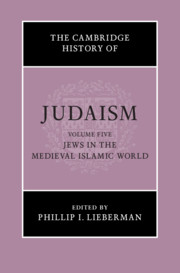Book contents
Introduction
Published online by Cambridge University Press: 21 August 2021
Summary
The period covered by this volume – from roughly 600 to 1500 ce – witnessed radical transformations both within the Jewish community itself and in the broader contexts in which the Jews found themselves. By focusing on the Islamicate world, this volume necessarily engages questions about how the development, rise, and maturation of Islam itself from its cradle in the Arabian Peninsula to its florescence and expansion from the Iberian Peninsula in the West to India and China in the East shaped that context. The rise of Islam and its penetration into Byzantine, Sasanian Persian, and Visigothic domains had a decisive influence on Jews and Judaism in these regions as the conditions of daily life and elite culture shifted throughout the Islamicate world. At the outset of this period, the vast majority of world Jewry lived in the “East,” with the spiritual and demographic center of Babylonia/Iraq occupying a place of particular prominence. Islamic conquest and expansion would come to have a definite effect on the shape of the Jewish community as the center of gravity shifted west to the North African communities, and long-distance trading opportunities led to the establishment of trading diasporas as far from the early centers as the Malabar Coast of India. Of course, with the turn of the millennium, the seedling Jewish communities of Christian Europe would begin to take root. By the end of our period, many of the communities on the “other” side of the Mediterranean had come into their own – while many of the Jewish communities in the Islamicate world had retreated from their high-water mark. Here, too, developments in the broader Islamic context – the rise of the Berber Almoravid (al-Murābiṭ) and Almohad (al-Muwaḥḥid) dynasties in the West, the Ayyūbid and Mamlūk sultanates in North Africa and the Levant, and the Mongol Īlkhāns in the East – trickled down to all levels of Jewish society and significantly transformed Jewish life. Although there would be areas of continued Jewish flourishing and creativity – particularly in the areas of piyyuṭ, mysticism, and rabbinic literature in the form of legal responsa (teshuvot), these shifts in the broader society led to a retrenchment of many aspects of Jewish life. The history of medieval Jewish civilization, then, is inextricably entwined with that of Islam. And as some amount of people, texts, practices, and ideas migrated from the Islamicate world to the Christian world in this period and were therefore at least partially responsible for nurturing Jewry on both north and south of the divided Mediterranean intellectually, spiritually, religiously, and even organizationally, Jewish life in Islamic lands produced a heritage that provided a formative impress on subsequent Jewish life in Christian Europe.
- Type
- Chapter
- Information
- The Cambridge History of Judaism , pp. 1 - 30Publisher: Cambridge University PressPrint publication year: 2021

